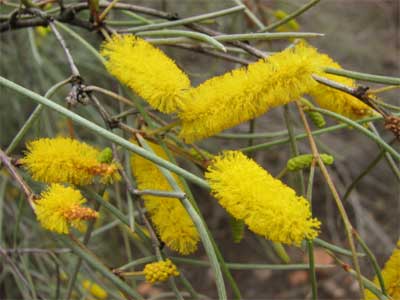
Acacia aneura
Family: Fabaceae
Highly variable shrub to small tree, ranging from one to 14m in height but most commonly a bushy shrub 3 to 5m high.
Cylindrical flower spikes are bright yellow and appear after rain events.
Mulga can dominate vegetation types such as woodlands and the acidity of the fallen phyllodes (equivalent to leaves) can inhibit the growth of an understorey.
Mulga is killed by fire but requires the heat from the fire to activate germination of the seed. Often vast stands of similar age and height plants are found when a germination event occurs after a fire.
It is a common plant of arid inland Australia, being found in the Northern Territory, South Australia, Western Australia, Queensland and New South Wales. This plant is highly adapted to life in the arid regions, the phyllodes and branches grow upwards to catch any available moisture and direct it like a funnel to the root zone.
Mulga plants are often a host for mistletoe (which have an edible fruit), grow mulga apples (an edible gall produced by insects) and the lerp scale can be found on the branches (the source of honey for honey ants).
Where to find this plant at Alice Springs Desert Park
Throughout the park, along the entry road and in the Mulga Woodland habitat (where the Nocturnal Tours are conducted).
Sources:
Moore, P., 2005. A Guide to Plants of Inland Australia, Reed New Holland, Sydney
Urban, A., 2004. Wildflowers and Plants of Inland Australia, Paul Fitzsimons, Alice Springs